What is the Star-Delta Starter
A star-delta starter is a common and cost-effective method for starting a three-phase induction motor.
When you start a large electrical motor, in the first few seconds that the motor is starting it will draw (6-8) times the rated current; this is called the inrush or start current.
This current increase will definitely damage the motor and cause a damaging shock in the electrical network. So, when you start a large electrical motor, you need to control and decrease this start current.
One of the common ways to do this is to use a Star – Delta starter for your electrical motor. So, you first start the motor in a Star connection and after a few seconds, you’ll change the connection to a Delta.
When you start in the Star connection, the current that the motor draws is 1/3rd of the current for that motor in the Delta connection.
So now let’s go to figure out what is the difference between Star and Delta connection.
Star Connection
The star connection consists of four wires out of which three wires are phase wires that carry current and one is the neutral wire. This neutral wire helps to prevent electrical equipment from overcurrent and voltage. Star connection can be implemented using three wires or four wires. If only three phase wires are used then it is known as 3 phase 3 wire system. If three-phase wires and one neutral wire are used it is known as a Three-phase four-wire system.
- The line voltage (voltage between any two phases) is higher than the phase voltage (voltage across a single winding) by a factor of the square root of 3.
The line voltage is calculated as:
$$ V_{\text {line }}=\sqrt{3} \cdot V_{\text {phase }}$$
- The line current (current in any one of the line conductors) is equal to the phase current (current flowing through a single winding)
The line current is calculated as:
$$I_{\text {line }}=I_{\text {phase }}$$
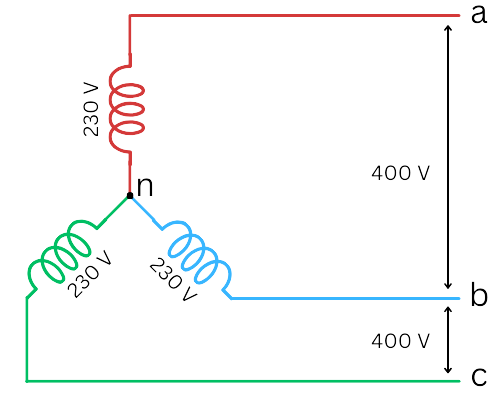
Delta Connection
Delta connection consists of only three phase wires. The neutral wire is not used in the delta connection. As the neutral wire is not used in a delta connection it cannot prevent the circuit from over-current.
- The line voltage (voltage between any two phases) is equal to the phase voltage (voltage across a single winding)
The line voltage is calculated as:
$$V_{\text{line}}=V_{phase}$$
- The line current (current in any one of the line conductors) is higher than the phase current (current flowing through a single winding) by a factor of the square root of 3.
The line current is calculated as:
$$I_{\text {line }}=\sqrt{3} \cdot I_{\text {phase }}$$
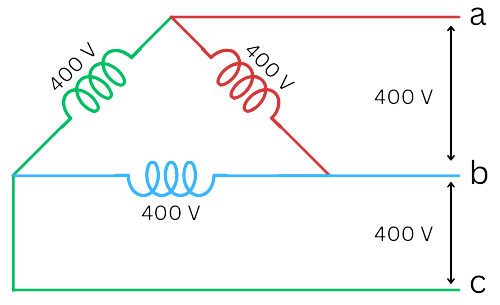
Now that we understand the difference between Star and Delta connections, we know why the starting current in a Star connection is lower than the Delta connection. So, how does a motor actually start in Star and then switch to Delta?
Now, Let’s see how can run a motor with this method.
How Star – Delta Starter Works
When you open the terminal box of any three-phase motor, you’ll typically find six terminals. They represent the incoming (U1 , V1 , W1 ) and ends (U2 , V2 , W2 ) of the three internal windings. And how we connect these terminals together determines whether the motor runs in a Star or Delta configuration.
So, for the Star connection, you just need to connect the ends of windings together (U2 , V2 , W2 ).
When a motor runs in a Star connection, each of its internal windings does not receive the full voltage from the power line. Instead, it gets only about 58% of the line voltage (technically, the line voltage divided by the square root of 3), which effectively reduces the starting current.
And for the Delta connection, you need to connect (U1 to W2), (V1 to U2)and (W1 to V2).
The basic concept of Star-Delta starter is to first run the motor in the Star connection for a few seconds to reduce the start current. Then when the motor has gained sufficient speed usually about 70-80% of its full operating speed, change the windings connections to Delta.
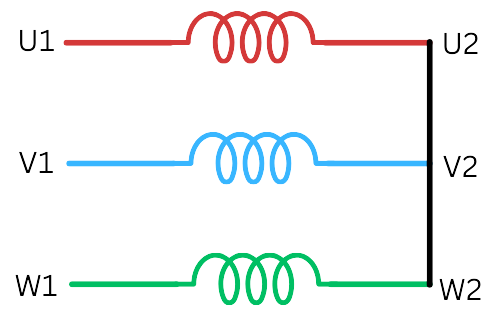
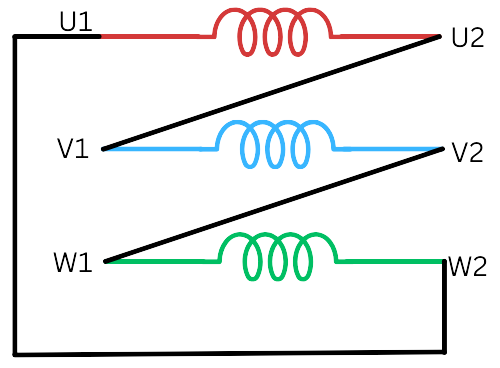
The question is. How to change the connection automatically?
Power Circuit of Star-Delta Starter
To run a three-phase motor under normal conditions, you connect the three-phase power to the incoming terminals of the motor in the terminal box. But to better control the motors run request, you can add the contactor in the way of coming power, we call this contactor the Main contractor.
If you want the motor winding connections to be in star, you can add a contactor and connect the power contacts of the contactor to the (U2 , V2 , W2 ), and short the circuit the other ends of the contactor’s contacts, so we call this the Star contactor.
With this wiring, when both the main and star contactors are energized at the same time, the motor has started in star connection.
After a few seconds, change a connection to Delta, to do this we need to add another contactor, we call this the Delta contactor. You should first wire the three main contacts of the contactor to the (U2 , V2 , W2 ), then need to wire the other ends of the contactor’s contact to(L1, L2, L3) respectively.
Now what happens in this situation? When both the main and the delta contactors are energized and the contacts are closed, U1 will be connected to W2 , V1 will be connected to U2 and W1 will be connected to V2. This is what you need to have the motor runs as Star-Delta Starter.
So when the Main and the Star contactors are energized at the same time the connection will be is Star, and when the Main and Delta connections are energized the connection will be in Delta.
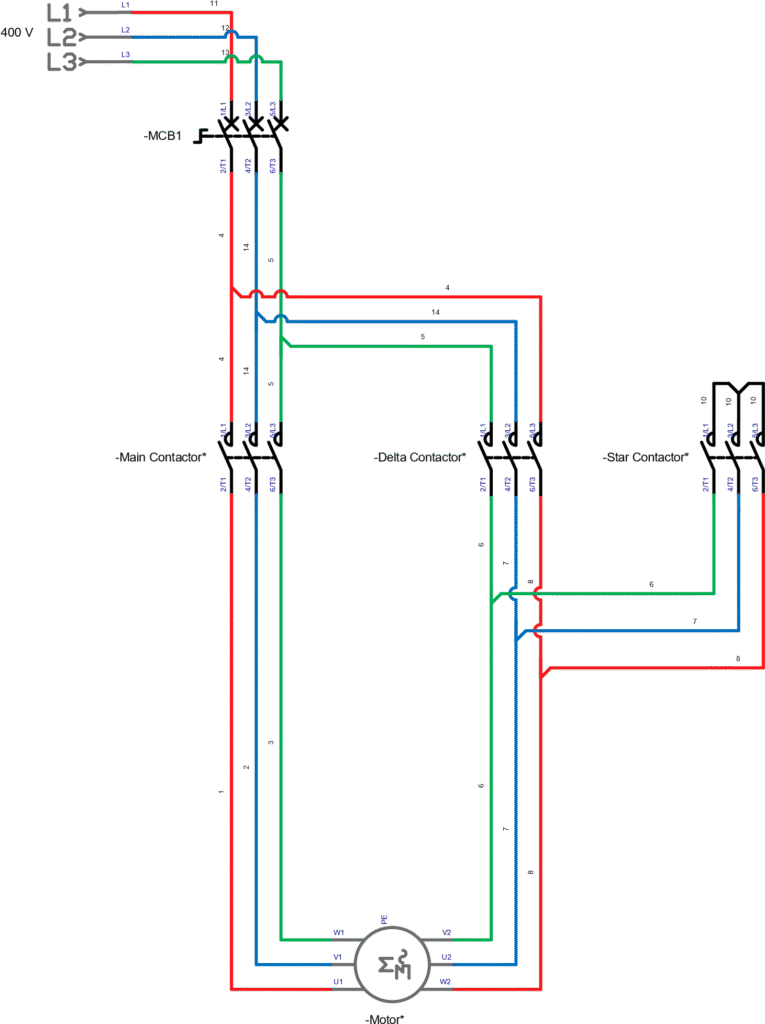
Control Circuit of Star-Delta Starter
First, the main circuit braker (MCB) must be closed to supply power to the circuit. When you press the Start Push-Button (Start_PB), both the Main Coil and the Timer are energized.
The energized Main Coil causes its normally open Main Contact to close. This contact acts as a “latch”, keeping the circuit powered even after you release the Start button. At the same time, the Star Coil is energized, causing the motor to start and run in the star connection. This initial phase typically lasts for a few seconds.
After the preset time on the Timer has passed, its contacts will switch their states. The timer contact in the star coil’s path opens, de-energizing the Star Coil. Simultaneously, the timer contacts in the delta coil’s path closes, energizing the Delta Coil. The motor now running in the delta connection for its normal operation.
An essential safety feature is the electrical interlock provided by the normally closed contacts on the star and delta contactors. This design ensures that the star and delta coils can never be energized at the same time, which would cause a severe short circuit.
To stop the motor, you can press the Stop Pushbutton (Stop_PB). In an emergency, pressing the Emergency Stop (EMG_PB) will also immediately cut power to the entire control circuit, stopping the motor.
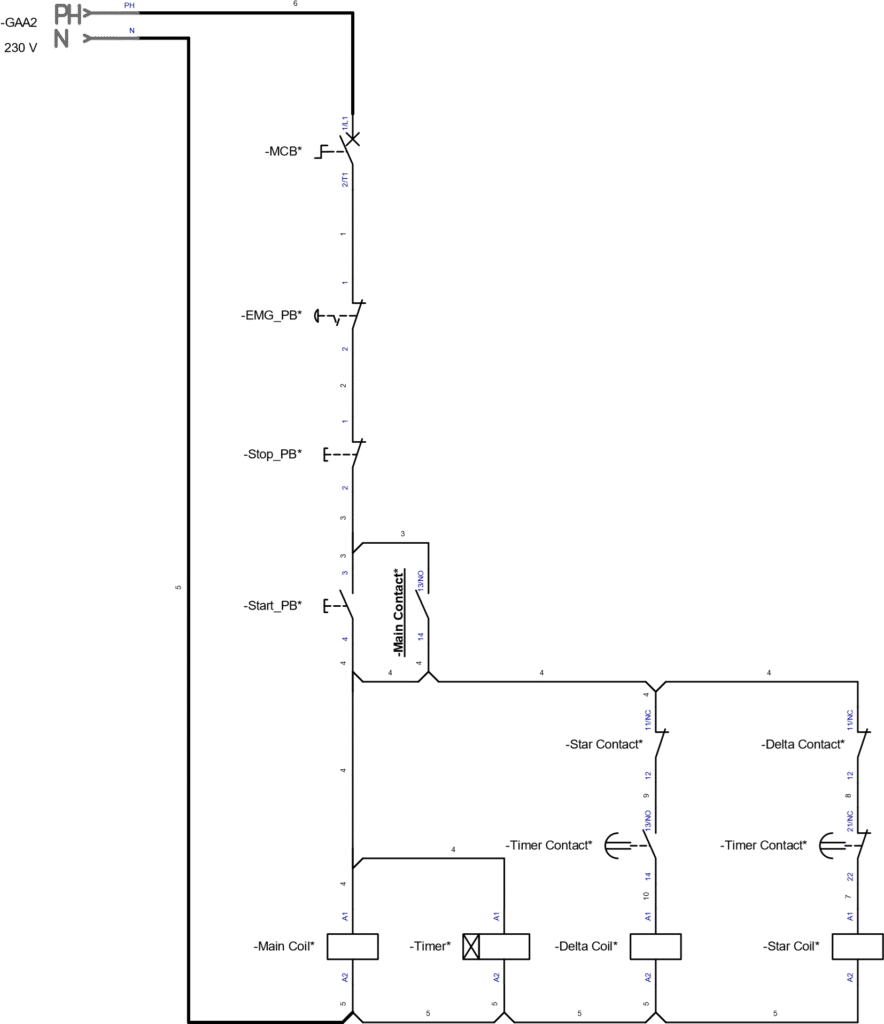
Advantages
- The components to set up the circuit are cheap.
- Reduced starting current by 33% of what the direct online starting consumes. So it protect the circuit.
- Overload relay size can be reduced to about 50% because it operates under low starting voltage and currents.
Disadvantages
- Reduced starting torque by 33%, this can be a major issue for applications that required a high starting torque to overcome heavy initial loads.
- This starting method is only suitable for motors that are specifically designed to have both ends of their three windings accessible.
- A momentary yet significant current spike can occur during the transition from the star to the delta connection.

